Forecasting Ocean Mesoscale Eddies in the Northwest Pacific in a Dynamic Ocean Forecast System
Abstract
1. Introduction
2. Materials and Methods
2.1. The Forecast Dataset
2.2. The Observational Dataset
2.3. Eddy Identification and Tracking Algorithms
2.4. Match Forecasts with Observations
2.5. Region Selection
3. Results
3.1. Overview of the Forecast Result
3.2. Matched Eddies
3.3. Statistics of Correct, Missing, and False Eddies
3.4. Relationships Between Eddy Features and Distance of the Correctly Forecasted Eddies
4. Discussion
4.1. Influence of Forecasting Density
4.2. Sensitivity of Results to Matching Criteria
5. Conclusions
- (1)
- In general, LFS forecasts a smaller number of eddies (8%), with lower mean amplitudes (22%), larger mean radius (4%), and faster mean (24%).
- (2)
- The spatial characteristics of these correct, missing, and false eddies are similar to those of the total forecasted eddies. However, in most grids, the correct eddies exhibited larger amplitudes compared to the missing, false, and total eddies. This finding has practical implications, as eddies with larger amplitudes are more likely to be correctly forecasted in operational applications.
- (3)
- Similarly, we found a significant correlation between forecast location errors with the observed amplitude and . For eddies with larger amplitudes and slower , LFS demonstrated greater accuracy in predicting their location.
- (4)
- Moreover, LFS correctly predicted 63% of the OMEs in the NWP region, while 37% of the OMEs were missed, and 31% of the forecasted eddies were false at a lead time of 1 day. Differences exist in the correct, false, and missing rate, which is partly associated with the number of forecast eddies.
Supplementary Materials
Author Contributions
Funding
Data Availability Statement
Conflicts of Interest
References
- Nikurashin, M.; Ferrari, R. Suppression of Eddy Diffusivity across Jets in the Southern Ocean. J. Phys. Oceanogr. 2010, 40, 1501–1519. [Google Scholar] [CrossRef]
- Chaigneau, A.; Le Texier, M.; Eldin, G.; Grados, C.; Pizarro, O. Vertical structure of mesoscale eddies in the eastern South Pacific Ocean: A composite analysis from altimetry and Argo profiling floats. J. Geophys. Res. Ocean. 2011, 116, C11025. [Google Scholar] [CrossRef]
- Ueno, H.; Bracco, A.; Barth, J.A.; Budyansky, M.V.; Hasegawa, D.; Itoh, S.; Kim, S.Y.; Ladd, C.; Lin, X.; Park, Y.-G.; et al. Review of oceanic mesoscale processes in the North Pacific: Physical and biogeochemical impacts. Prog. Oceanogr. 2023, 212, 102955. [Google Scholar] [CrossRef]
- Ferrari, R.; Klocker, A.; LaCasce, J.H. Estimating Suppression of Eddy Mixing by Mean Flows. J. Phys. Oceanogr. 2012, 42, 1566–1576. [Google Scholar] [CrossRef]
- Chelton, D.B.; Schlax, M.G.; Samelson, R.M. Global observations of nonlinear mesoscale eddies. Prog. Oceanogr. 2011, 91, 167–216. [Google Scholar] [CrossRef]
- Liu, Y.; Dong, C.; Guan, Y.; Chen, D.; McWilliams, J.; Nencioli, F. Eddy analysis in the subtropical zonal band of the North Pacific Ocean. Deep Sea Res. Part I Oceanogr. Res. Pap. 2012, 68, 54–67. [Google Scholar] [CrossRef]
- Chelton, D.B.; Schlax, M.G.; Samelson, R.M.; de Szoeke, R.A. Global observations of large oceanic eddies. Geophys. Res. Lett. 2007, 34, L15606. [Google Scholar] [CrossRef]
- Chelton, D.B.; Gaube, P.; Schlax, M.G.; Early, J.J.; Samelson, R.M. The Influence of Nonlinear Mesoscale Eddies on Near-Surface Oceanic Chlorophyll. Science 2011, 334, 328–332. [Google Scholar] [CrossRef]
- McGillicuddy, D.J. Mechanisms of Physical-Biological-Biogeochemical Interaction at the Oceanic Mesoscale. Annu. Rev. Mar. Sci. 2016, 8, 125–159. [Google Scholar] [CrossRef]
- Zhang, Z.; Wang, W.; Qiu, B. Oceanic mass transport by mesoscale eddies. Science 2014, 345, 322–324. [Google Scholar] [CrossRef]
- Qiu, B.; Chen, S. Eddy-Induced Heat Transport in the Subtropical North Pacific from Argo, TMI, and Altimetry Measurements. J. Phys. Oceanogr. 2005, 35, 458–473. [Google Scholar] [CrossRef]
- Dong, C.; McWilliams, J.C.; Liu, Y.; Chen, D. Global heat and salt transports by eddy movement. Nat. Commun. 2014, 5, 3294. [Google Scholar] [CrossRef]
- Brach, L.; Deixonne, P.; Bernard, M.-F.; Durand, E.; Desjean, M.-C.; Perez, E.; van Sebille, E.; ter Halle, A. Anticyclonic eddies increase accumulation of microplastic in the North Atlantic subtropical gyre. Mar. Pollut. Bull. 2018, 126, 191–196. [Google Scholar] [CrossRef]
- Gilchrist, R.M.; Hall, R.A.; Bacon, J.C.; Rees, J.M.; Graham, J.A. Increased dispersion of oil from a deep water seabed release by energetic mesoscale eddies. Mar. Pollut. Bull. 2020, 156, 111258. [Google Scholar] [CrossRef]
- Frenger, I.; Gruber, N.; Knutti, R.; Münnich, M. Imprint of Southern Ocean eddies on winds, clouds and rainfall. Nat. Geosci. 2013, 6, 608–612. [Google Scholar] [CrossRef]
- Braun, C.D.; Gaube, P.; Sinclair-Taylor, T.H.; Skomal, G.B.; Thorrold, S.R. Mesoscale eddies release pelagic sharks from thermal constraints to foraging in the ocean twilight zone. Proc. Natl. Acad. Sci. USA 2019, 116, 17187–17192. [Google Scholar] [CrossRef] [PubMed]
- Xing, Q.; Yu, H.; Wang, H.; Ito, S.i.; Chai, F. Mesoscale eddies modulate the dynamics of human fishing activities in the global midlatitude ocean. Fish Fish. 2023, 24, 527–543. [Google Scholar] [CrossRef]
- Chassignet, E.P.; Hurlburt, H.E.; Smedstad, O.M.; Halliwell, G.R.; Hogan, P.J.; Wallcraft, A.J.; Bleck, R. Ocean Prediction with the Hybrid Coordinate Ocean Model (HYCOM). In Ocean Weather Forecasting: An Integrated View of Oceanography; Chassignet, E.P., Verron, J., Eds.; Springer: Dordrecht, The Netherlands, 2006; pp. 413–426. [Google Scholar]
- Hurlburt, H.E.; Chassignet, E.P.; Cummings, J.A.; Kara, A.B.; Metzger, E.J.; Shriver, J.F.; Smedstad, O.M.; Wallcraft, A.J.; Barron, C.N. Eddy-Resolving Global Ocean Prediction. In Ocean Modeling in an Eddying Regime; Hecht, M.W., Hasumi, H., Eds.; American Geophysical Union: Washington, DC, USA, 2008; pp. 353–381. [Google Scholar]
- Thoppil, P.G.; Frolov, S.; Rowley, C.D.; Reynolds, C.A.; Jacobs, G.A.; Joseph Metzger, E.; Hogan, P.J.; Barton, N.; Wallcraft, A.J.; Smedstad, O.M.; et al. Ensemble forecasting greatly expands the prediction horizon for ocean mesoscale variability. Commun. Earth Environ. 2021, 2, 89. [Google Scholar] [CrossRef]
- Krishnamurthy, V. Predictability of Weather and Climate. Earth Space Sci. 2019, 6, 1043–1056. [Google Scholar] [CrossRef]
- Roberts, C.D.; Balmaseda, M.A.; Tietsche, S.; Vitart, F. Sensitivity of ECMWF coupled forecasts to improved initialization of the ocean mesoscale. Q. J. R. Meteorol. Soc. 2022, 148, 3694–3714. [Google Scholar] [CrossRef]
- Wang, X.; Wang, H.; Liu, D.; Wang, W. The Prediction of Oceanic Mesoscale Eddy Properties and Propagation Trajectories Based on Machine Learning. Water 2020, 12, 2521. [Google Scholar] [CrossRef]
- Ma, C.; Li, S.; Wang, A.; Yang, J.; Chen, G. Altimeter Observation-Based Eddy Nowcasting Using an Improved Conv-LSTM Network. Remote Sens. 2019, 11, 783. [Google Scholar] [CrossRef]
- Chen, L.; Han, B.; Wang, X.; Zhao, J.; Yang, W.; Yang, Z. Machine Learning Methods in Weather and Climate Applications: A Survey. Appl. Sci. 2023, 13, 12019. [Google Scholar] [CrossRef]
- Xu, D.; Zhuang, W.; Yan, Y. Could the two anticyclonic eddies during winter 2003/2004 be reproduced and predicted in the northern South China Sea? Ocean Sci. 2019, 15, 97–111. [Google Scholar] [CrossRef]
- Li, J.; Wang, G.; Xue, H.; Wang, H. A simple predictive model for the eddy propagation trajectory in the northern South China Sea. Ocean Sci. 2019, 15, 401–412. [Google Scholar] [CrossRef]
- Chen, X.; Chen, G.; Ge, L.; Cao, C.; Huang, B. Medium-range forecasting of oceanic eddy trajectory. Int. J. Digit. Earth 2024, 17, 2300325. [Google Scholar] [CrossRef]
- Fox-Kemper, B.; Adcroft, A.; Böning, C.W.; Chassignet, E.P.; Curchitser, E.; Danabasoglu, G.; Eden, C.; England, M.H.; Gerdes, R.; Greatbatch, R.J.; et al. Challenges and Prospects in Ocean Circulation Models. Front. Mar. Sci. 2019, 6, 65. [Google Scholar] [CrossRef]
- Liu, H.; Chu, P.; Meng, Y.; Ding, M.; Lin, P.; Ding, R.; Wang, P.; Zheng, W. The Predictability Limit of Oceanic Mesoscale Eddy Tracks in the South China Sea. Adv. Atmos. Sci. 2024, 41, 1661–1679. [Google Scholar] [CrossRef]
- Meng, Y.; Liu, H.; Lin, P.; Ding, M.; Dong, C. Oceanic mesoscale eddy in the Kuroshio extension: Comparison of four datasets. Atmos. Ocean. Sci. Lett. 2021, 14, 100011. [Google Scholar] [CrossRef]
- Ding, M.; Liu, H.; Lin, P.; Meng, Y.; Yu, Z. Evaluating westward and eastward propagating mesoscale eddies using a 1/10° global ocean simulation of CAS-LICOM3. Ocean Model. 2024, 189, 102373. [Google Scholar] [CrossRef]
- Liu, H.; Lin, P.; Zheng, W.; Luan, Y.; Ma, J.; Ding, M.; Mo, H.; Wan, L.; Ling, T. A global eddy-resolving ocean forecast system in China—LICOM Forecast System (LFS). J. Oper. Oceanogr. 2021, 16, 15–27. [Google Scholar] [CrossRef]
- Zheng, W.; Lin, P.; Liu, H.; Luan, Y.; Ma, J.; Mo, H.; Liu, J. An assessment of the LICOM Forecast System under the IVTT class4 framework. Front. Mar. Sci. 2023, 10, 1112025. [Google Scholar] [CrossRef]
- Lin, P.; Yu, Z.; Liu, H.; Yu, Y.; Li, Y.; Jiang, J.; Xue, W.; Chen, K.; Yang, Q.; Zhao, B.; et al. LICOM Model Datasets for the CMIP6 Ocean Model Intercomparison Project. Adv. Atmos. Sci. 2020, 37, 239–249. [Google Scholar] [CrossRef]
- Lellouche, J.-M.; Greiner, E.; Le Galloudec, O.; Garric, G.; Regnier, C.; Drevillon, M.; Benkiran, M.; Testut, C.-E.; Bourdalle-Badie, R.; Gasparin, F.; et al. Recent updates to the Copernicus Marine Service global ocean monitoring and forecasting real-time 1∕12° high-resolution system. Ocean Sci. 2018, 14, 1093–1126. [Google Scholar] [CrossRef]
- Li, Q.-Y.; Sun, L.; Lin, S.-F. GEM: A dynamic tracking model for mesoscale eddies in the ocean. Ocean Sci. 2016, 12, 1249–1267. [Google Scholar] [CrossRef]
- Faghmous, J.H.; Frenger, I.; Yao, Y.; Warmka, R.; Lindell, A.; Kumar, V. A daily global mesoscale ocean eddy dataset from satellite altimetry. Sci. Data 2015, 2, 150028. [Google Scholar] [CrossRef]
- Pegliasco, C.; Delepoulle, A.; Mason, E.; Morrow, R.; Faugère, Y.; Dibarboure, G. META3.1exp: A new global mesoscale eddy trajectory atlas derived from altimetry. Earth Syst. Sci. Data 2022, 14, 1087–1107. [Google Scholar] [CrossRef]
- Jacob, J.P.; Chassignet, E.P.; Dewar, W.K. Influence of Topography on the Propagation of Isolated Eddies. J. Phys. Oceanogr. 2002, 32, 2848–2869. [Google Scholar] [CrossRef]
- Zhai, X.; Johnson, H.L.; Marshall, D.P. Significant sink of ocean-eddy energy near western boundaries. Nat. Geosci. 2010, 3, 608–612. [Google Scholar] [CrossRef]
- Chelton, D.B.; Samelson, R.M.; Early, J.J. The Evolution and Propagation of Quasigeostrophic Ocean Eddies*. J. Phys. Oceanogr. 2011, 41, 1535–1555. [Google Scholar] [CrossRef]
- Ni, Q.; Zhai, X.; Wang, G.; Marshall, D.P. Random Movement of Mesoscale Eddies in the Global Ocean. J. Phys. Oceanogr. 2020, 50, 2341–2357. [Google Scholar] [CrossRef]
- Wilson, C. Does the wind systematically energize or damp ocean eddies? Geophys. Res. Lett. 2016, 43, 12538–12542. [Google Scholar] [CrossRef]
- Ding, M.; Liu, H.; Lin, P.; Hu, A.; Meng, Y.; Li, Y.; Liu, K. Overestimated Eddy Kinetic Energy in the Eddy-Rich Regions Simulated by Eddy-Resolving Global Ocean–Sea Ice Models. Geophys. Res. Lett. 2022, 49, e2022GL098370. [Google Scholar] [CrossRef]
- Chassignet, E.P.; Yeager, S.G.; Fox-Kemper, B.; Bozec, A.; Castruccio, F.; Danabasoglu, G.; Horvat, C.; Kim, W.M.; Koldunov, N.; Li, Y.; et al. Impact of horizontal resolution on global ocean–sea ice model simulations based on the experimental protocols of the Ocean Model Intercomparison Project phase 2 (OMIP-2). Geosci. Model Dev. 2020, 13, 4595–4637. [Google Scholar] [CrossRef]
- Chen, G.; Hou, Y.; Chu, X. Mesoscale eddies in the South China Sea: Mean properties, spatiotemporal variability, and impact on thermohaline structure. J. Geophys. Res. 2011, 116, C06018. [Google Scholar] [CrossRef]
- Qu, T. Upper-Layer Circulation in the South China Sea. J. Phys. Oceanogr. 2000, 30, 1450–1460. [Google Scholar] [CrossRef]
- Wang, L.; Koblinsky, C.J.; Howden, S. Mesoscale variability in the South China Sea from the TOPEX/Poseidon altimetry data. Deep Sea Res. Part I Oceanogr. Res. Pap. 2000, 47, 681–708. [Google Scholar] [CrossRef]
- Qiu, B. Seasonal Eddy Field Modulation of the North Pacific Subtropical Countercurrent: TOPEX/Poseidon Observations and Theory. J. Phys. Oceanogr. 1999, 29, 2471–2486. [Google Scholar] [CrossRef]
- Yang, C.; Yang, H.; Chen, Z.; Gan, B.; Liu, Y.; Wu, L. Seasonal variability of eddy characteristics and energetics in the Kuroshio Extension. Ocean Dyn. 2023, 73, 531–544. [Google Scholar] [CrossRef]
- Pilo, G.S.; Mata, M.M.; Azevedo, J.L.L. Eddy surface properties and propagation at Southern Hemisphere western boundary current systems. Ocean Sci. 2015, 11, 629–641. [Google Scholar] [CrossRef]



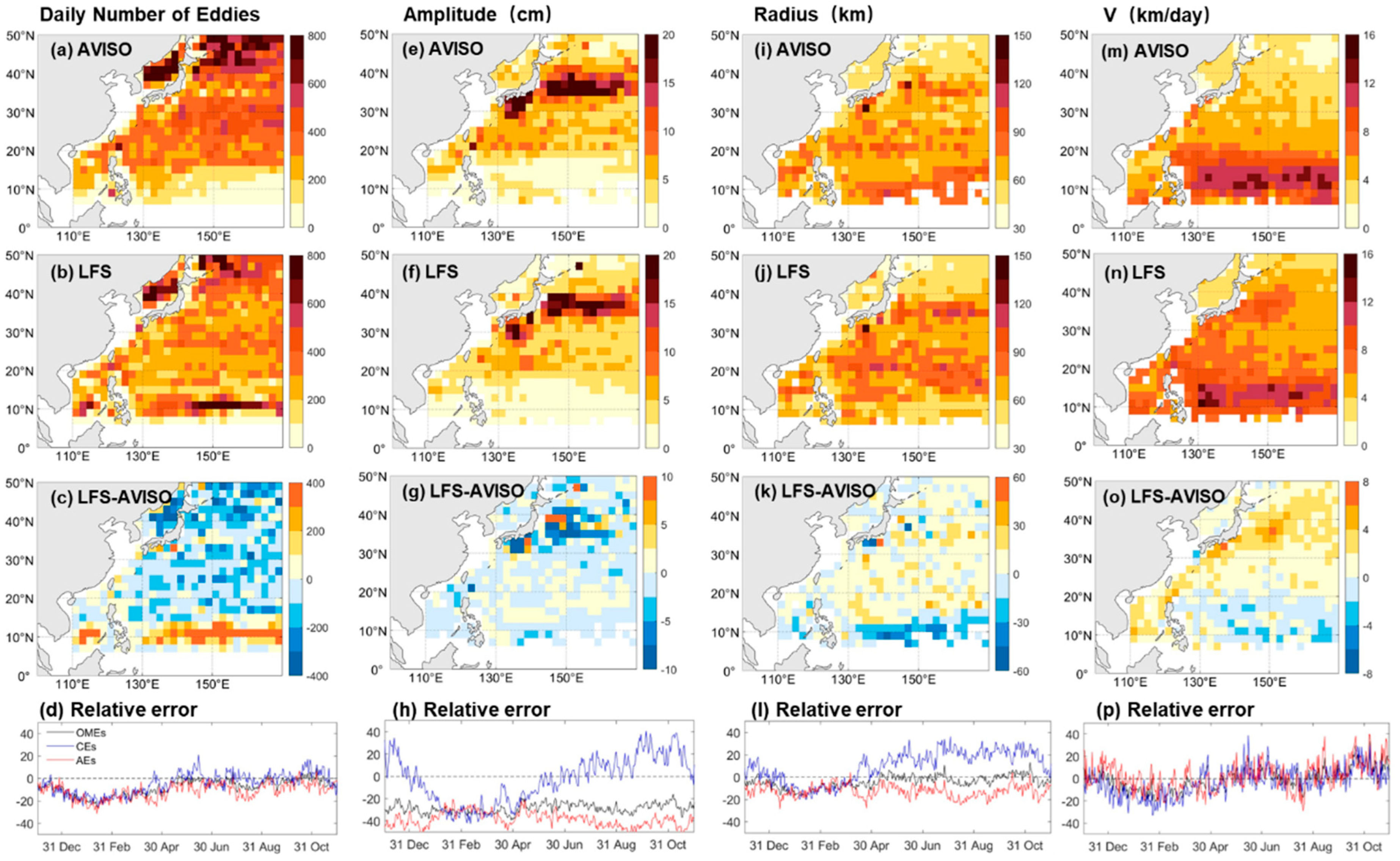

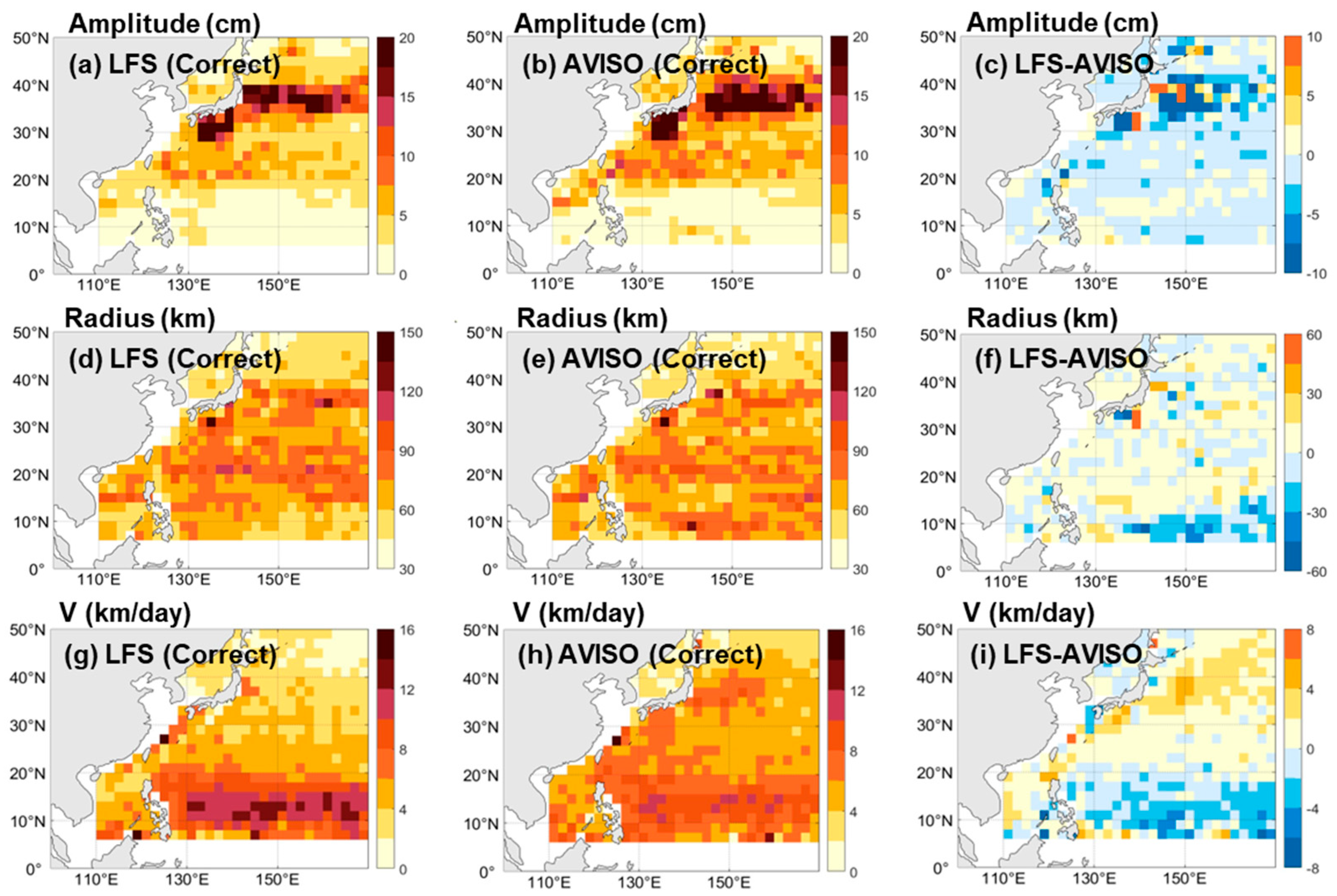
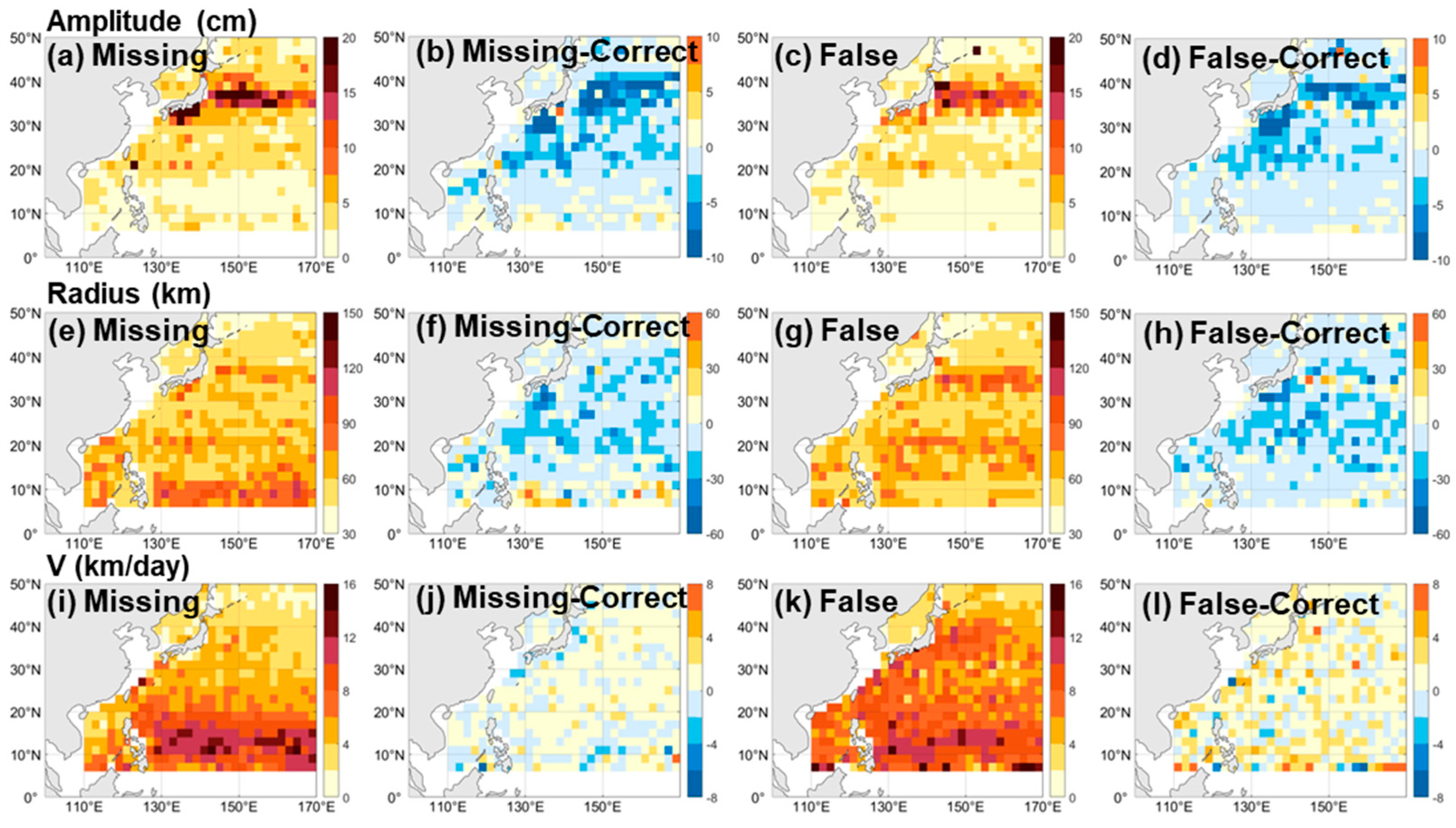
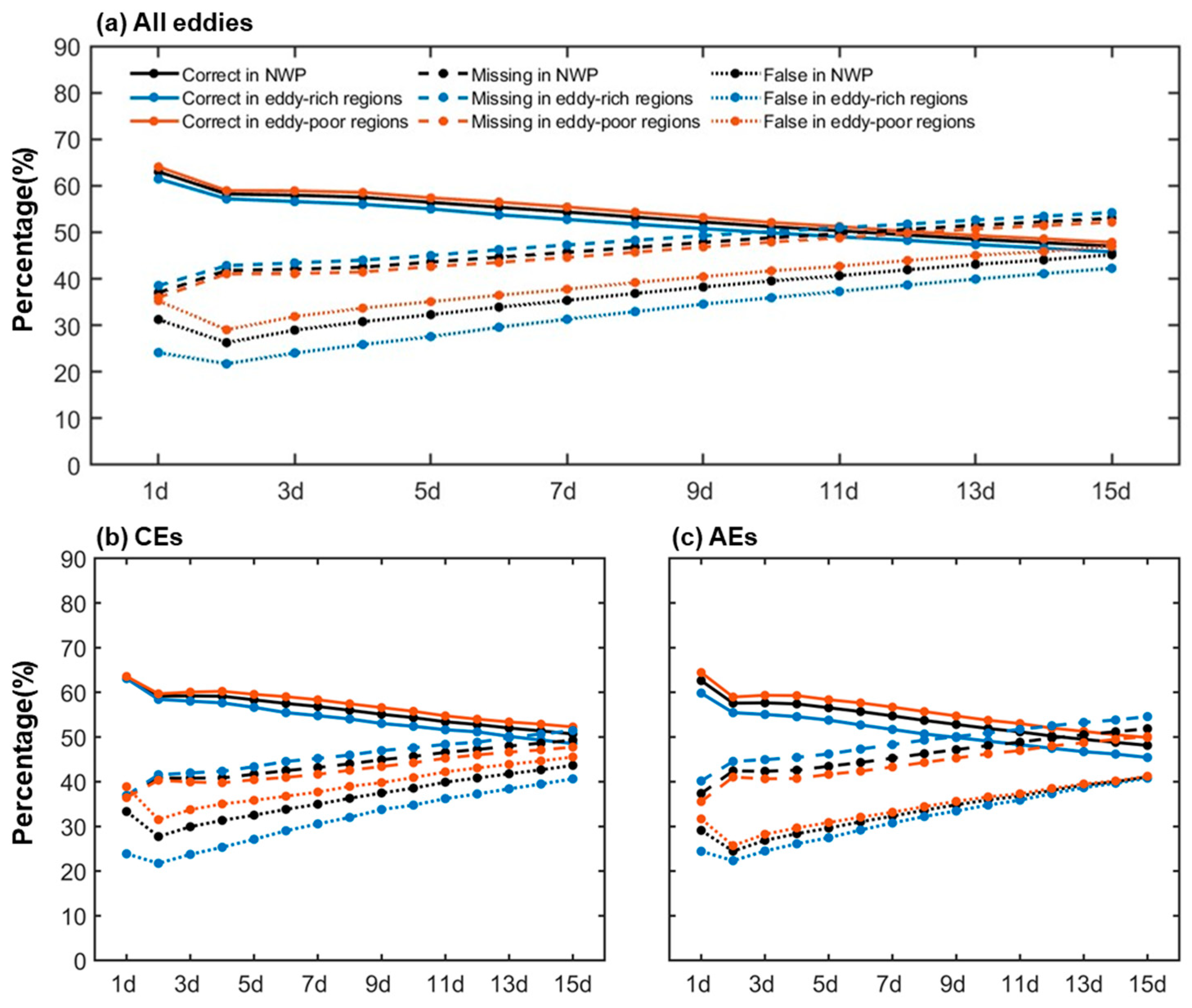
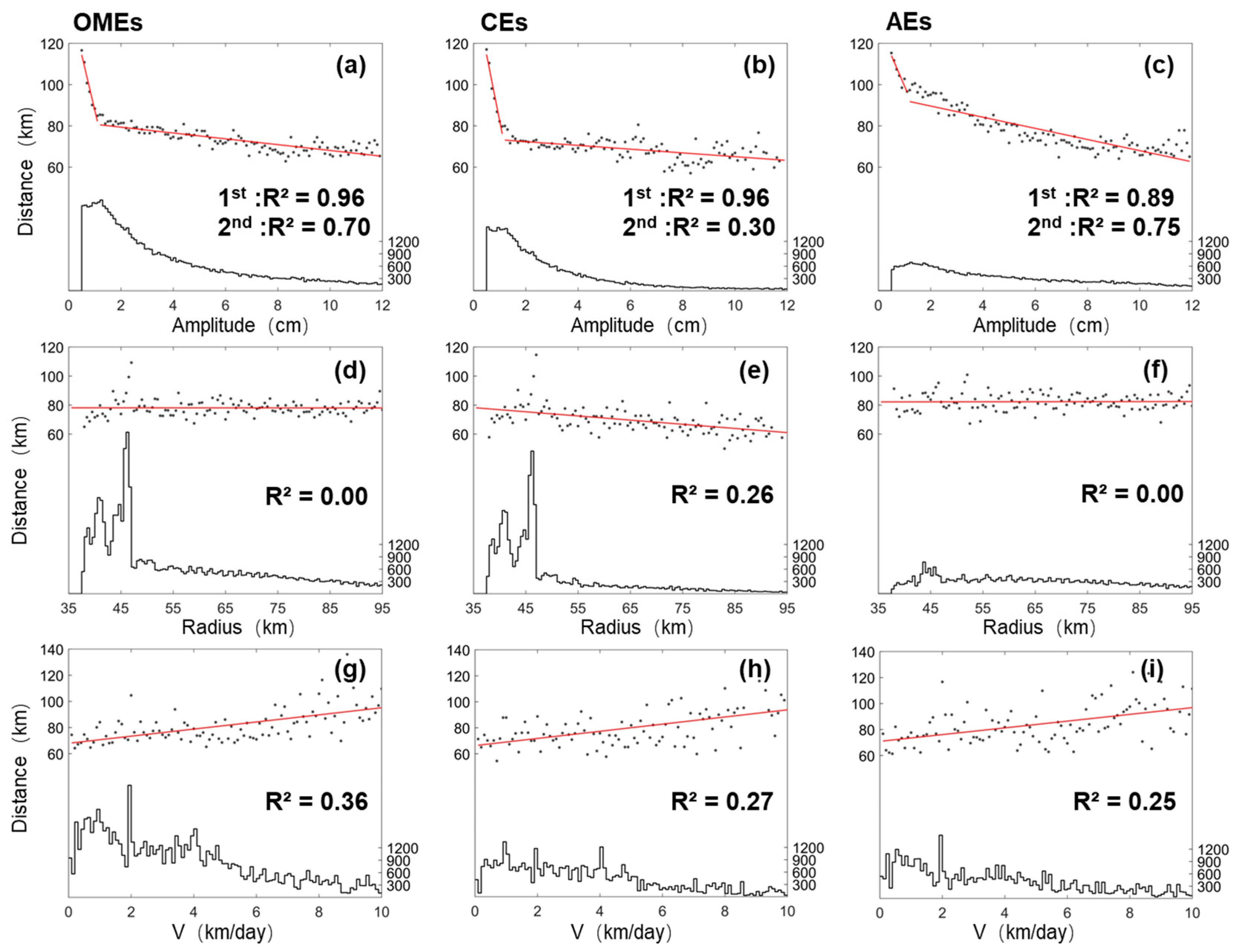


| Lead Time | AVISO | 1 Day | 3 Days | 5 Days | 7 Days | 9 Days | 11 Days | 13 Days | 15 Days | |
|---|---|---|---|---|---|---|---|---|---|---|
| Daily Number | Mean | 422.75 | 387.84 | 345.44 | 352.82 | 355.94 | 357.95 | 359.33 | 361.32 | 363.27 |
| STD | 42.20 | 20.79 | 19.81 | 18.67 | 19.84 | 19.26 | 19.46 | 19.92 | 17.66 | |
| Amplitude (cm) | Mean | 5.65 | 4.42 | 4.72 | 4.67 | 4.65 | 4.67 | 4.66 | 4.67 | 4.65 |
| STD | 7.93 | 6.4 | 6.6 | 6.57 | 6.52 | 6.53 | 6.54 | 6.52 | 6.48 | |
| Radius (km) | Mean | 62.64 | 65.36 | 66.51 | 66.13 | 65.86 | 65.74 | 65.5 | 65.46 | 65.27 |
| STD | 27.62 | 28.56 | 29.35 | 29.13 | 28.93 | 28.77 | 28.49 | 28.4 | 28.33 | |
| V (km/day) | Mean | 4.37 | 5.45 | 5.60 | 5.64 | 5.67 | 5.74 | 5.82 | 5.94 | 5.81 |
| STD | 3.88 | 5.44 | 5.11 | 4.95 | 4.92 | 5.06 | 5.24 | 5.82 | 6.25 | |
| NWP | Eddy-Rich Region | Eddy-Poor Region | |
|---|---|---|---|
| 148,809 | 60,872 | 87,937 | |
| 136,333 | 49,334 | 86,999 | |
| 93,721 | 37,416 | 56,305 | |
| 62.98 | 61.47 | 64.03 | |
| 37.02 | 38.53 | 35.97 | |
| 31.26 | 24.16 | 35.28 |
Disclaimer/Publisher’s Note: The statements, opinions and data contained in all publications are solely those of the individual author(s) and contributor(s) and not of MDPI and/or the editor(s). MDPI and/or the editor(s) disclaim responsibility for any injury to people or property resulting from any ideas, methods, instructions or products referred to in the content. |
© 2025 by the authors. Licensee MDPI, Basel, Switzerland. This article is an open access article distributed under the terms and conditions of the Creative Commons Attribution (CC BY) license (https://creativecommons.org/licenses/by/4.0/).
Share and Cite
Zhang, J.; Liu, H.; Ding, M.; Meng, Y.; Zheng, W.; Lin, P.; Yu, Z.; Li, Y.; Wang, P.; Chen, J. Forecasting Ocean Mesoscale Eddies in the Northwest Pacific in a Dynamic Ocean Forecast System. J. Mar. Sci. Eng. 2025, 13, 1571. https://doi.org/10.3390/jmse13081571
Zhang J, Liu H, Ding M, Meng Y, Zheng W, Lin P, Yu Z, Li Y, Wang P, Chen J. Forecasting Ocean Mesoscale Eddies in the Northwest Pacific in a Dynamic Ocean Forecast System. Journal of Marine Science and Engineering. 2025; 13(8):1571. https://doi.org/10.3390/jmse13081571
Chicago/Turabian StyleZhang, Jiakang, Hailong Liu, Mengrong Ding, Yao Meng, Weipeng Zheng, Pengfei Lin, Zipeng Yu, Yiwen Li, Pengfei Wang, and Jian Chen. 2025. "Forecasting Ocean Mesoscale Eddies in the Northwest Pacific in a Dynamic Ocean Forecast System" Journal of Marine Science and Engineering 13, no. 8: 1571. https://doi.org/10.3390/jmse13081571
APA StyleZhang, J., Liu, H., Ding, M., Meng, Y., Zheng, W., Lin, P., Yu, Z., Li, Y., Wang, P., & Chen, J. (2025). Forecasting Ocean Mesoscale Eddies in the Northwest Pacific in a Dynamic Ocean Forecast System. Journal of Marine Science and Engineering, 13(8), 1571. https://doi.org/10.3390/jmse13081571






